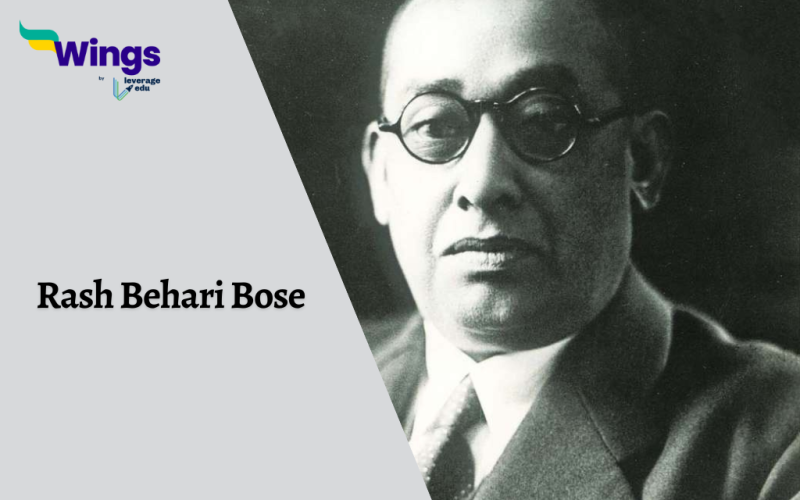Rash Behari Bose was an Indian revolutionary leader who fought tooth and nail against British rule in India. He was a key figure in the Indian National Army (INA) which was an armed force formed in Japan during World War 2.
Table of Contents
Who was Rash Behari Bose?
Born on the 25th of May, 1886, in West Bengal, Rash Behari Bose grew up witnessing immense famines and pandemics during the British rule in India. This was the reason he disliked the Britishers which led to the revolutionary nature of his persona. Furthermore, Rash Behari Bose had been profoundly impacted by the French Revolution in 1789 and sought after the principles of equality, fraternity and liberty. He soon got implicated in revolutionary activities while studying at Dupleix College in Chandernagore, a French colony in India.
Also Read: What is the Difference between Governor-General and Viceroy?
What were the Revolutionary Activities by Rash Behari Bose?
There were quite a few revolutionary activities that the revolutionary participated in as well as led:
Delhi-Lahore Conspiracy
In 1912, there was an attempt made to assassinate Lord Hardinge, the then Viceroy of India. The conspiracy was hatched by underground Indian revolutionaries from Bengal and Punjab and it was led by Rash Behari Bose. The attempt took place on the day the capital of British rule was being shifted from Calcutta to Delhi. The homemade bomb was thrown at the Viceroy during the ceremonial procession that was passing through Chandni Chowk. Even though Rash Behari Bose had been identified as the person who threw the bomb, for three years Bose successfully evaded being captured.

Ghadar Mutiny
The Ghadar Mutiny also known as the Ghadar Conspiracy happened to be a strategy to commence a pan-India uprising in the British Indian Army in February 1915 so as to end the British rule in India. Rash Behari Bose was one of the key masterminds behind the revolution which sought to strike the British army from the inside and thus promote movements against British rule. The members of the movement were called Ghadarites and they were sent into several cantonments to infiltrate into the army with the purpose to win over the rest of the soldiers who had not gone to war in Europe. The revolution saw a defeat and many of the revolutionists were captured. Later, Rash Behari Bose escaped British intelligence and in 1915 arrived in Japan.
Indian Independence League
The contribution of Rash Behari Bose was monumental in the leadership and establishment of the Indian Independence League (IIL). Since Bose was living in exile in Japan, in 1931 he organised the first Indian Independence League meeting where the league proclaimed their objective- “the attainment of independence of India by all possible means.” In March 1942, Rash Behari Bose called together a conference of other Indian nationalist groups across the Asia-Pacific region which led to the establishment of the Indian Independence League. Along with A.M. Nair, a fellow Indian activist, he put forth a motion to build an army for Indian Independence and foresaw the army to fight for India’s independence from the British.
Also Read: Indian Freedom Fighters who Studied Abroad
How was Rash Behari Bose involved with the Indian National Army?
The Indian National Army (INA) also known as the Azad Hind Fauj, was established and led by Rash Behari Bose. He built the organisational structure from scratch and played a significant role in spreading the idea of winning India’s freedom with aid and assistance from Japan. Bose was the middleman and representative of the aims of the INA with the Japanese association. During the brief disbandment, Rash Behari Bose managed to hold the INA together till June 1943 when Subhas Chandra Bose took over the leadership of the INA.
Quiz
Results
#1. In which year was the attempt made to assassinate Lord Hardinge?
#2. In which year did the Ghadar Mutiny commence?
#3. When did Subhas Chandra Bose take over the reins of the Indian National Army from Rash Behari Bose?
Relevant Blogs
| Lord Lansdowne | Lord Irwin |
| Lord Lytton | Lord Chelmsford |
| The Government of India Act 1919 | Civil Disobedience Movement |
| Morley-Minto Reforms | Gandhi Irwin Pact (1931) |
| Bengal Partition | Chalukya Dynasty |
We hope you liked reading our blog If you want to read more articles like this you can visit our general knowledge page on Indian History!
 One app for all your study abroad needs
One app for all your study abroad needs
















